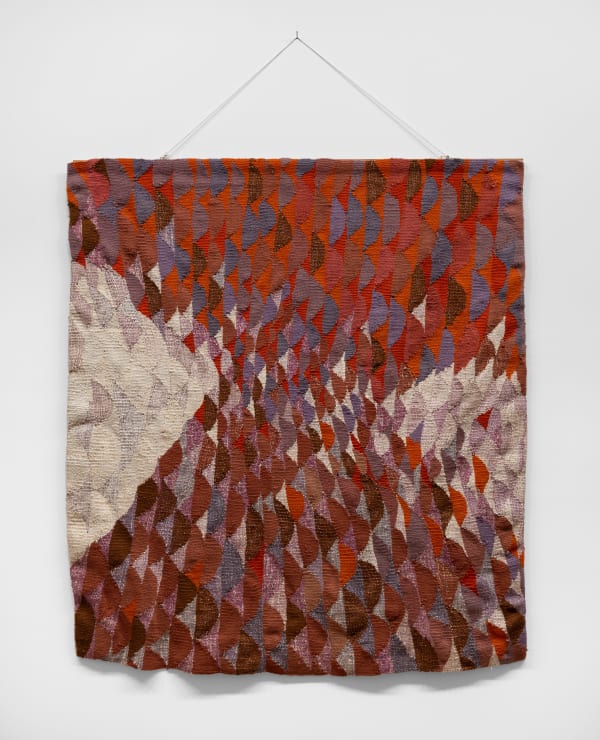Charles Moffett is pleased to present Improvisational Nature: The Weavings and Drawings of Silvia Heyden, the first New York solo exhibition for the late tapestry weaver Silvia Heyden (1927 - 2015), and the first exhibition of the artist’s tapestries and drawings in the U.S. since 1972. The exhibition brings together ten tapestries, as well as a selection of works on paper, made by the artist between 1973 to 2014. Born in Basel, Switzerland, Heyden’s life journeyed back and forth from Switzerland to Durham, North Carolina where she settled with her family; a path that was tangential to the predominant European and American developments in modern tapestry that shaped the field of fiber-based art throughout the 20th century. Working against the prevailing orientation of tapestry toward mass production and the grid, Heyden’s practice recalled pre-medieval tapestry techniques and further expanded the medium’s potential for vibrant expression, intrinsic rhythm, and visual complexity. Brilliantly hued and remarkably intricate, the tapestries on view embody Heyden’s original approach to the medium that she relentlessly pursued throughout the course of her life.
As a student at the School of Applied Arts in Zurich in the late 1940s and early 1950s, Heyden studied under the instruction of former Bauhaus master Johannes Itten, and Elsi Giauque, a former student of the Dadaist Sophie Taeuber-Arp. Heyden learned to synthesize the color-theory, materiality, and geometry of the Bauhaus with the experimental and expressive lessons of Surrealism. However, by the time she graduated in 1952, both instructors and the school more broadly had begun to dismiss weaving as simply representational, decorative craft that was past redemption. Heyden was determined though. Newly inspired by a visit to the tapestries at the Museum of History in her hometown in Basel, she was convinced there was enormous potential in further developing the techniques of pre-medieval tapestries and she dedicated herself to the pursuit and realization of that belief.
Before the invention and widespread use of paper, artists created tapestries through a material-driven approach to the textile. This changed beginning in the Renaissance and the use of full-sized preparatory cartoons that guided the weavers’ hand in a largely preconceived approach to tapestry weaving. Driven to return to that earlier, more improvisational method, Heyden trained herself to weave free of any preparatory cartoon. Particularly after she and her family moved to North Carolina in 1966 when her husband joined Duke as a professor in epidemiology, she increasingly worked with threads in a manner that she would describe as primarily “tactile” - without the mediation of a shuttle that would have resulted in the common horizontal weft. A lifelong violinist, for Heyden, directly handling textile threads was akin to the experience of manipulating strings on a violin. Enchanted and propelled by the building of rhythms and textures through weaving, she rejected the loom’s predilection for grids or regular intervals, and instead created curves and folds, expanding the material and dimensional potentials of tapestry.
For Heyden, much of the beauty and fascination of weaving began with the integral nature of figure and ground, both of which the weaver has to create at once, unlike a drawing upon paper or a painting upon a canvas. The traditional way of weaving is from the bottom up, joining threads of different colors in horizontal lines, but for Heyden that strict horizontality was too static; her lines had to move and swing. Much of her inspiration for this movement came from nature. First among the mountains of Switzerland and later the rivers and mountains of rural North Carolina, the artist would take daily walks, absorbing the endless forms and constant motions of natural phenomena — water, wind, light, grass, trees, animals, birds, etc.— bringing them back to her studio in the form of visceral memories to translate through the loom. She once remarked of her extensive time spent traversing the path of North Carolina’s Eno River:
“I have spent countless hours taking in the beauty of the Eno River…While the river flows infinitely down with a life of its own, I must work within the confined space of a tapestry on the wall, which is a composition with its own laws and rules. On the loom it flows back and forth in repeating weft threads from the bottom up. The result is a very textile look at the river. I never go down to the river and draw something which would give me a tapestry, instead I teach myself how to weave the fluid forms and patterns in the water.”
Silvia Heyden (b. 1927, Basel, Switzerland; d. 2015, Durham, North Carolina) graduated from School of Design, Zurich, Switzerland in 1952. Heyden received a number of commissions for public works in the U.S. and Europe throughout her lifetime, including most prominently commissions for the Bankers Trust Company in New York (1968), the Concert Hall of the City of Brennen, Germany (1977), and the Town Hall in San Nazzaro, Switzerland (2003). She had her first major exhibition at the Duke University Museum of Art in 1972, followed by exhibitions in the U.S., primarily in North Carolina, Switzerland, and Germany. Her most significant exhibition to-date was presented by the Textile Museum of St. Gallen, Switzerland in 1994. Heyden’s work is held in museum collections and civic institutions primarily across the U.S., including the Mint Museum in Charlotte, NC, the North Carolina State Museum of Art, the Durham County Library, and the Williams College Museum of Art in Williamstown, MA, among others.
Works
Installation Views
Press release








